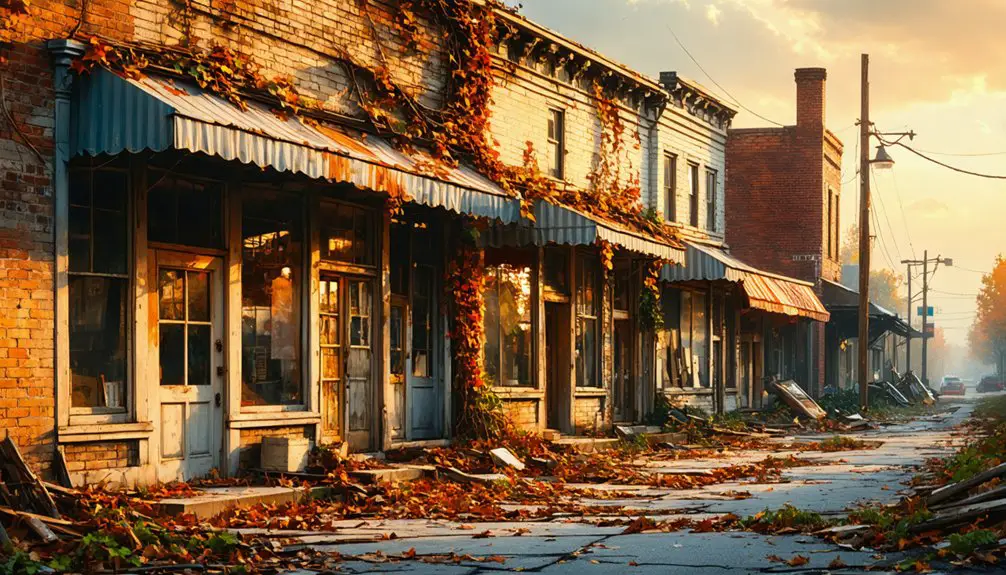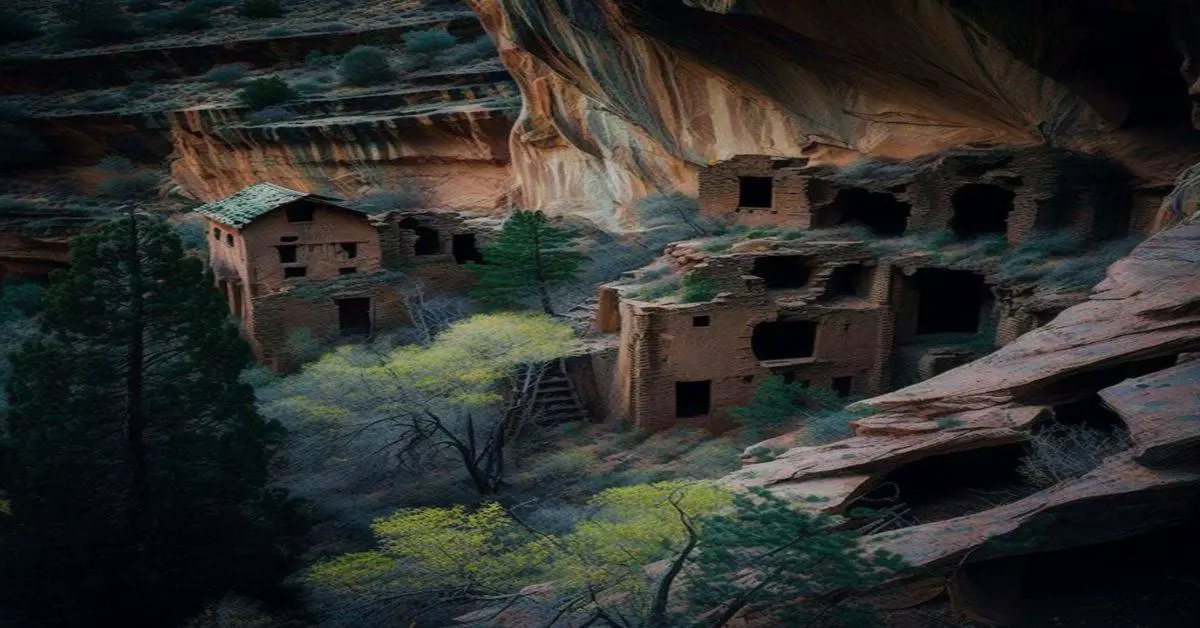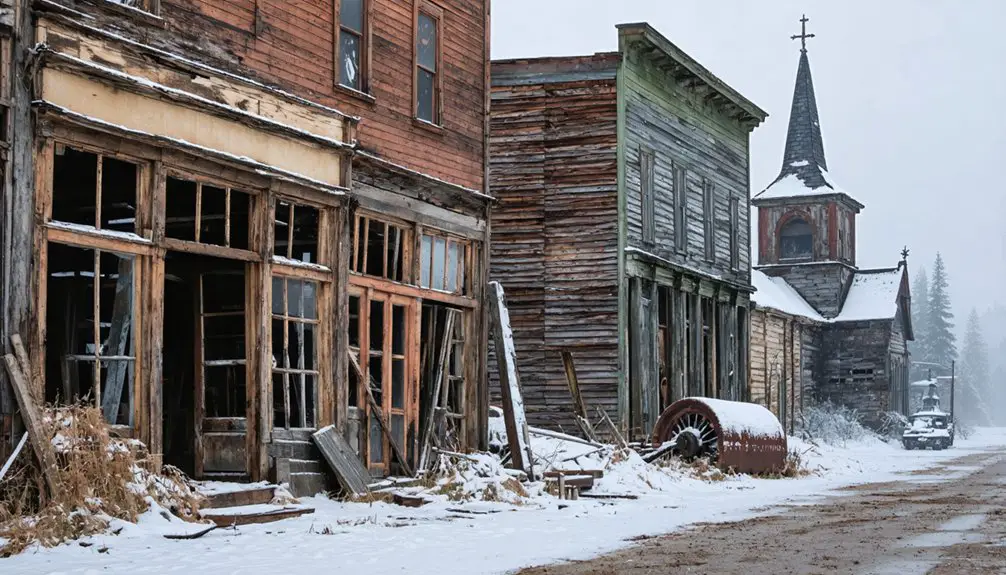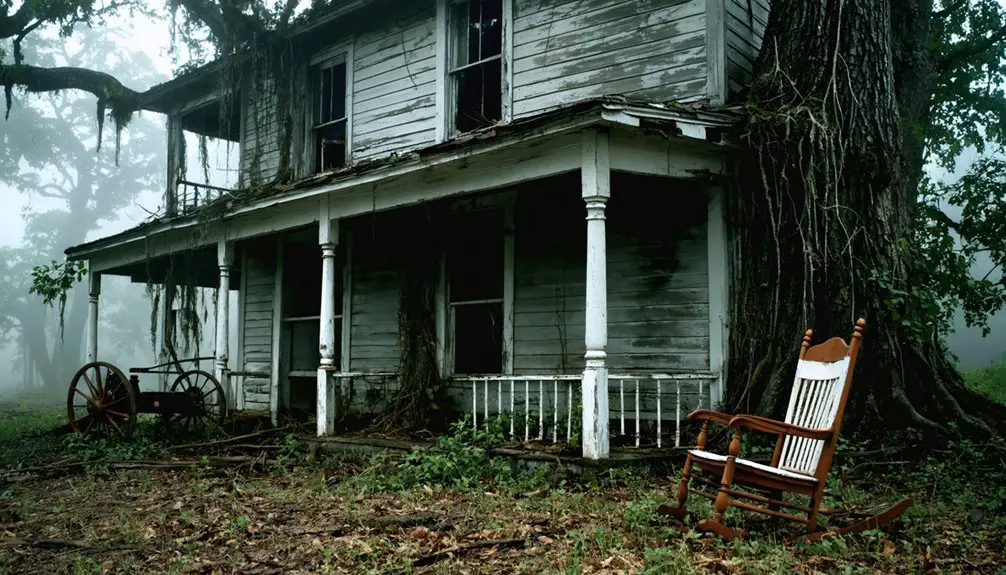You’ll find Glade’s ghostly remnants in the hills of West Virginia, where a once-bustling lumber empire operated from the 1880s to 1930s. The company town thrived through its narrow-gauge railways, band saw mills, and the crucial 750-foot Glade Creek Railroad Bridge, processing 17 acres of virgin forest daily. Today, nature has reclaimed the abandoned buildings and rail lines, while the ruins tell stories of industrial prosperity, social stratification, and environmental transformation that shaped Appalachian history.
Key Takeaways
- Glade was a thriving lumber town in West Virginia that became abandoned after timber resources were depleted in the 1930s.
- The Blue Jay Lumber Company operated four locomotives and processed 17 acres of virgin forest daily during peak operations.
- The town’s social structure was strictly controlled by the company, with housing assignments based on job positions.
- The dismantling of the 750-foot Glade Creek Railroad Bridge in 1942 severed the town’s vital transportation link.
- Nature has reclaimed the abandoned town site, with second-growth forests demonstrating environmental recovery of the industrial landscape.
The Birth of a Logging Empire
When the railroad first penetrated West Virginia’s remote wilderness in the late 19th century, it sparked the birth of a logging empire in Glade and nearby Hamlet.
You’ll find that early logging techniques relied heavily on manual labor, with rugged crews wielding hand saws and axes while draft horses dragged massive logs to the railheads.
As the timber trade flourished, narrow gauge rail lines snaked deeper into the ancient forests, revealing vast stands of old-growth deciduous trees. The introduction of band saw mills in 1881 revolutionized timber production in the region. The Glade Creek and Raleigh Railroad established a vital 15-mile route from New River to the Grandview plateau.
Life in the Company Town
The rise of logging operations transformed Glade into a classic company town, where every aspect of daily life fell under corporate control.
You’d find your home assigned based on your position – supervisors and engineers enjoyed ornate houses, while laborers crowded into basic row housing renting for $5.99 monthly plus fees.
The community dynamics reflected strict social stratification. While you could enjoy company-provided recreation at the pool halls and bowling alleys, management maintained their exclusive country clubs and golf courses.
Your social life revolved around company-sponsored events designed to foster loyalty and prevent labor unrest. The Blue Jay Lumber Company established early dominance in harvesting the region’s vast timber resources. The Raleigh Coal & Coke Company emerged as another major industrial force, operating six productive mines in the early 1900s. The company town’s post office and community center served as essential gathering spots, but this carefully constructed social order lasted only as long as the timber did.
Like clockwork, workers gathered at company events – a carefully orchestrated dance to maintain order and prevent rebellion.
Once resources depleted, Glade’s infrastructure and buildings fell into abandonment.
Railroad Bridge: Lifeline of the Community
Standing majestically over the New River, Glade Creek’s 750-foot railroad bridge served as the community’s essential artery during the lumber boom years. Today, the World’s Highest Truss Bridge stands nearby at a towering height of 700 feet.
You’d have seen massive timber loads crossing its metal spans daily, connecting the isolated company towns of Glade and Hamlet to the outside world. The bridge’s significance extended beyond mere transportation – it was the lifeline that enabled the region’s economic prosperity, facilitating the export of lumber and coal while bringing in crucial supplies for mill operations.
The Chesapeake and Ohio Railway took charge of dismantling the bridge during the war effort. When timber resources were depleted by the 1930s, the bridge’s fate was sealed. Its metal superstructure was later salvaged for World War II efforts, and the remaining pier ruins stand as silent witnesses to the area’s economic decline.
The bridge’s dismantling marked the end of an era in Glade’s history.
Peak Years of Timber Production
During Glade’s timber boom from the 1880s to 1930s, Blue Jay Lumber Company‘s operations transformed this quiet mountain region into a bustling industrial hub.
You’d have witnessed massive timber production with four locomotives hauling logs along the Glade Creek line, while teams of loggers felled trees by hand and used draft horses to transport logs down mountainsides.
The introduction of the band saw in 1881 revolutionized logging techniques, allowing mills to process about 17 acres of virgin forest daily. The development of the Shay geared locomotive in the 1870s enabled more efficient transport of logs across rough mountain terrain.
At its peak, Hamlet’s population of 100-200 workers kept the mills running constantly, shipping lumber via the C&O Railroad to industrial cities like Cleveland and Pittsburgh. The original forests of West Virginia covered over 15 million acres of valuable old-growth timber before commercial logging began.
The machine shop fabricated equipment on-site, while the mill pond and sawmills processed the endless stream of timber until the old-growth forests were completely exhausted by the 1930s.
Environmental Legacy and Forest Recovery
You’ll find remarkable evidence of nature’s resilience in Glade’s ghost town landscape, where hardwood forests have reclaimed the barren slopes left by decades of intensive logging.
The century-long recovery showcases how secondary growth forests, though different from their old-growth predecessors, have restored essential ecosystem functions and wildlife habitats across the region’s ridges and valleys. Similar natural restoration could help address the unreclaimed mine sites that currently pose environmental hazards to local communities. With an estimated cleanup cost of $20 billion needed to remediate remaining abandoned coal mines, natural regeneration offers a complementary approach to healing the land.
While these regenerated forests lack the complexity of ancient stands, they represent an impressive natural rebirth that’s occurred without human intervention, protected now within state and national parklands.
Nature’s Resilient Return
After decades of intensive logging devastated the landscape around Glade, nature’s remarkable resilience has transformed the abandoned town into a symbol of ecological recovery.
You’ll find mixed hardwood forests now thriving where industrial mills and railway lines once dominated, showcasing nature’s regeneration in action. The removal of human activity and infrastructure during WWII accelerated the area’s healing, as native species gradually reclaimed their territory.
Today, you can witness the results of this ecological resilience firsthand. The forest’s diverse age classes support abundant wildlife, while decomposing industrial remnants have enriched the soil.
What’s most striking is how completely nature has reasserted itself – the old foundations and artifacts now serve as silent witnesses to the forest’s triumph, reminding us of nature’s power to heal when given the chance.
Forest Ecosystems Rise Again
While the scars of intensive logging and mining operations once dominated Glade’s landscape, the area’s forest ecosystems have undergone a remarkable transformation since industrial abandonment.
You’ll now find mixed hardwood forests where barren industrial sites once stood, as nature steadily reclaimed its territory through forest regeneration. The abandoned rail beds and mining structures have become unique corridors for wildlife movement, while ecological diversity flourishes in the maturing second-growth forests.
The restored tree canopy filters water, stabilizes soil, and creates essential habitats for native species. As you explore these recovering woodlands, you’ll witness how the forest’s natural resilience has transformed Glade’s industrial past into a living symbol of environmental renewal, supporting everything from soil microbes to migratory birds.
The Final Days of Glade
You’d have heard the final whistle of Glade’s lumber mill echoing through the valley in the late 1930s, marking the end of decades of timber operations.
Walking through town shortly after, you’d have seen empty company houses standing in eerie silence as families packed up and moved away to find work elsewhere.
The last physical connection to Glade’s prosperous past disappeared when crews dismantled the Glade Creek Railroad Bridge in 1942, using its steel for the World War II effort.
Last Mill Whistle Blows
The final chapter of Glade’s story unfolded during the 1930s when the last mill operations ground to a halt, silencing the familiar whistle that had echoed through the valley for decades.
You’d have witnessed the stark reality of depleted timber resources forcing mill after mill to close, leaving only mill memories in their wake.
The community’s resilience was tested as families packed up and moved away, searching for work elsewhere.
While French’s Mill held out until 1964, it too eventually succumbed to changing times.
You can still picture the dismantling of the narrow gauge railroads and bridges, their materials repurposed for the war effort.
The once-bustling hub of Appalachian industry fell silent, marking the end of an era when timber and steam powered the dreams of mountain folk.
Empty Houses Stand Silent
Peeling paint and rotting wood tell the story of Glade’s final chapter, as abandoned homes stand like hollow sentinels across the ghostly landscape.
You’ll find these silent witnesses stripped bare of the life that once filled them – no furniture, no personal belongings, just empty shells where families once thrived.
As you walk through Glade’s deteriorating streets, you’ll see the skeletal remains of what was once a vibrant community.
The worker houses, barns, and auxiliary buildings have succumbed to nature’s slow reclamation.
Where children once played and neighbors gathered, only decay remains.
These abandoned homes, now cleaned out and deserted, serve as a stark reminder of how quickly a town can vanish when its economic lifeblood runs dry.
Bridge Dismantled For War
During World War II‘s metal salvage drives, Glade’s massive 750-foot railroad bridge met its end as workers systematically dismantled it to support the war effort.
As the Chesapeake and Ohio Railroad oversaw the wartime infrastructure impact, you’d have witnessed the last physical connection between Glade and Hamlet being taken apart piece by piece.
This war resource mobilization dealt the final blow to these once-thriving logging towns, effectively sealing their fate as ghost towns.
- Steel girders that once carried lumber trains across the New River now transformed into wartime materials
- Bridge piers standing as silent sentinels, marking where the essential rail link once crossed
- Empty rail yards and abandoned mills surrounding the dismantled bridge site telling the story of Appalachia’s industrial past
Preserving Appalachian Industrial Heritage
While many Appalachian industrial sites face deterioration and environmental challenges, preservation efforts have emerged to protect these vital landmarks of America’s coal mining heritage. Through heritage conservation initiatives, you’ll find communities working to transform abandoned mines and industrial ruins into educational spaces that tell the story of the region’s pivotal role in national industrialization.
Industrial archaeology projects must carefully address environmental hazards like VOCs, mercury, and asbestos before sites can be safely repurposed.
You’ll see how these preservation efforts extend beyond just coal, incorporating the broader context of Appalachia’s timber industry and forest heritage. By securing federal historic tax credits and National Heritage Area designations, local groups are creating sustainable networks of historic sites that celebrate industrial heritage while supporting community revitalization and new economic opportunities.
Frequently Asked Questions
What Happened to the Families Who Lived in Glade After It Closed?
Like scattered leaves in autumn’s wind, you’d have watched families disperse to nearby towns seeking work, their community bonds stretched thin as they relocated, leaving memories behind.
Were There Any Schools or Churches Established in Glade?
You’d find limited records about education history or religious significance in this town, though similar logging communities typically had basic company-supported schools and at least one church for workers’ families.
What Was the Population of Glade During Its Peak Years?
While exact Glade demographics weren’t officially recorded, you can estimate its peak population was likely 300-400 residents during the early 1900s, based on comparable logging towns in the region’s history.
Did Any Other Industries Attempt to Establish Themselves in Glade?
You won’t find evidence of other industries taking root beyond the timber industry. Despite nearby coal mining attempts, the area remained solely focused on logging until its eventual abandonment.
What Native American Tribes Originally Inhabited the Glade Area?
You’ll find the Monongahela people established Native settlements first, followed by Fort Ancient culture. Later, the Shawnee tribes and Cherokee used this region for seasonal hunting and movement along warriors’ paths.
References
- https://kids.kiddle.co/List_of_ghost_towns_in_West_Virginia
- https://theclio.com/tour/1943
- https://minskysabandoned.com/2015/08/06/west-virginia-ghost-towns-part-2-thurmond/
- https://www.nps.gov/neri/learn/historyculture/glade-creek-hamlet.htm
- https://www.youtube.com/watch?v=kll2jHnGusI
- https://www.bobsmarket.com/blog/wvforesthistory
- https://mh3wv.org/wp-content/uploads/2021/05/Logging-the-Virgin-Forests-of-West-Virginia-PATC.pdf
- https://wvforestry.com/wp-content/uploads/2019/07/History_of_WVDOF.pdf
- https://www.hmdb.org/m.asp?m=197516
- https://www.nps.gov/neri/learn/historyculture/royal.htm



